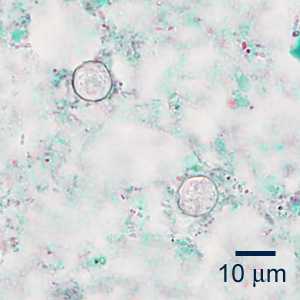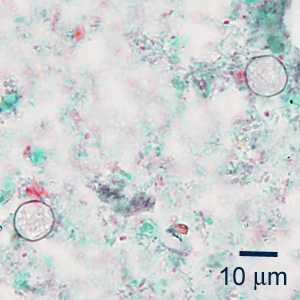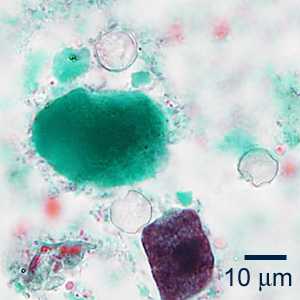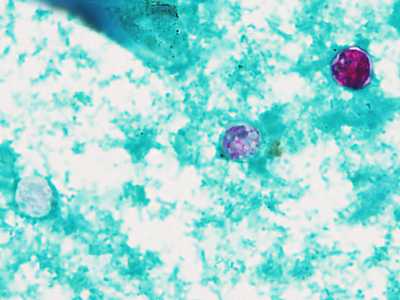
Case #353 - August, 2013
A 27-year-old man sought medical assistance for gastrointestinal symptoms that included watery diarrhea, abdominal pain, and fatigue. He reported no international travel within the last year. A fecal specimen was collected in zinc-PVA (polyvinyl alcohol) for ova-and-parasite (O&P) testing. A smear was prepared and stained with trichrome stain. Figures A-C show what was observed in moderately high numbers on the smear. What is your diagnosis? Based on what criteria?

Figure A

Figure B

Figure C
Case Answer
This was a case of cyclosporiasis caused by Cyclospora cayetanensis. Diagnostic features included round, refractile oocysts within the size range for C. cayetanensis.
Trichrome staining is not the recommend method for the morphologic diagnosis of cyclosporiasis. However, as this case illustrates, the oocysts can be detected if care is taken to look for round, unstained refractile objects of the correct size. A specimen preserved in 10% formalin was requested for confirmatory testing. Figure D shows variable staining of three oocysts on a smear stained using the modified Kinyoun's acid-fast (cold) method (viewed at 1000x magnification). Figure E shows two oocysts exhibiting autofluorescence when viewed using ultraviolet microscopy (viewed at 400x magnification). The two images were cropped to show the relative sizes of the oocysts at 1000x and 400x microscopy. The morphologic features shown using these two methods confirmed the diagnosis of Cyclospora. Further molecular testing (PCR) on the PVA-preserved material confirmed the species as C. cayetanensis.

Figure D

Figure E
More on: Cyclosporiasis
Images presented in the monthly case studies are from specimens submitted for diagnosis or archiving. On rare occasions, clinical histories given may be partly fictitious.
DPDx is an education resource designed for health professionals and laboratory scientists. For an overview including prevention and control visit www.cdc.gov/parasites/.
- Page last reviewed: August 24, 2016
- Page last updated: August 24, 2016
- Content source:
- Global Health – Division of Parasitic Diseases and Malaria
- Notice: Linking to a non-federal site does not constitute an endorsement by HHS, CDC or any of its employees of the sponsors or the information and products presented on the site.
- Maintained By:


 ShareCompartir
ShareCompartir